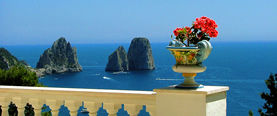- Capri
The etymology of the name Capri is unclear; it might either be traced back to the Ancient Greeks (Ancient Greek kapros meaning "wild boar"), the first recorded colonists to populate the island. But it could also derive from Latin capreae (goats). Fossils of wild boars have been discovered, lending credence to the "kapros" etymology, but on the other hand the Romans called Capri "goat island". Finally, there is also the possibility the name derives from an Etruscan word for "rocky", though any historical Etruscan rule of the island is disputed.
Capri is a large, limestone and sandstone rock. The sides of the island are perpendicular cliffs and the surface of the island is more cliffs.
Visit In Capri:
Faraglioni, rock formations, are one of the island's natural wonders. The faraglioni make up the classic view one associates with Capri. On the shore, the Faraglioni beach is one of the island's most beautiful beaches. There are several other unusual rock formations in the sea around the island, including a natural arch. (Faraglioni picture)
Anacapri, the highest town on the island, has splendid views of the harbor below. Near the central square there's a chair lift to Mount Solaro and a street lined with shops, several of which offer limoncello tasting. Olive trees, grapevines, and flowers give it a Mediterranean charm.
Villa San Michele, in Anacapri, was built by the Swedish writer Axel Munthe in the late 19th century on the site of a Tiberian villa. Bits of the Roman villa are incorporated into the atrium and garden. Inside are traditional local and Swedish furnishings and hundreds of art pieces from antiquity to the 20th century. Not to be missed are the garden with breathtaking views of the cliffs, harbor, and sea. Read more about visiting Villa San Michele and see pictures of the atrium and views.
Capri is the main town of the island. Piazza Umberto I, often called La Piazzetta, is the central square that houses cafes and the cathedral of Santo Stefano. The piazza is filled with people both day and night. There's an archaeological museum in the town.
Certosa of San Giacomo is a 14th century monastery near the town of Capri. It houses a museum and library and holds concerts. Nearby are the beautiful Giardini Augusto, gardens of Augustus. There's an overlook with great sea views. (picture of view of Via Krupp winding down to the sea)
Marina Piccola, the south harbor, has restaurants and a rocky beach with swimming. I had an excellent lunch on the terrace of Ciro' Restaurant with beautiful views of the sea and the Faraglioni rock formations. There are bathing establishments that rent sun beds or deck chairs for the day. The marina can be reached by bus or taxi.
Roman villa remains from the 12 elaborate villas built by Emperor Tiberius include Villa Jovis, in a spectacular position on Mount Tiberio, the most elaborate and interesting and the Sea Palace and Baths of Tiberius near Marina Grande.
Gallery









